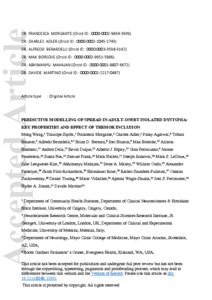Wang, M;
Sajobi, T;
Morgante, F;
Adler, C;
Agarwal, P;
Bäumer, T;
Berardelli, A;
Berman, BD;
Blumin, J;
Borsche, M;
et al.
Wang, M; Sajobi, T; Morgante, F; Adler, C; Agarwal, P; Bäumer, T; Berardelli, A; Berman, BD; Blumin, J; Borsche, M; Brashear, A; Deik, A; Duque, K; Espay, AJ; Ferrazzano, G; Feuerstein, J; Fox, S; Frank, S; Hallett, M; Jankovic, J; LeDoux, MS; Leegwater-Kim, J; Mahajan, A; Malaty, IA; Ondo, W; Pantelyat, A; Pirio-Richardson, S; Roze, E; Saunders-Pullman, R; Suchowersky, O; Truong, D; Vidailhet, M; Wagle Shukla, A; Perlmutter, JS; Jinnah, HA; Martino, D
(2021)
Predictive modeling of spread in adult-onset isolated dystonia: Key properties and effect of tremor inclusion.
EUROPEAN JOURNAL OF NEUROLOGY, 28 (12).
pp. 3999-4009.
ISSN 1351-5101
https://doi.org/10.1111/ene.15031
SGUL Authors: Morgante, Francesca
![[img]](https://openaccess.sgul.ac.uk/113503/1.hassmallThumbnailVersion/ene.15031.pdf)  Preview |
|
PDF
Accepted Version
Available under License ["licenses_description_publisher" not defined].
Download (887kB)
| Preview
|
Abstract
Background and purpose
Several clinical and demographic factors relate to anatomic spread of adult-onset isolated dystonia, but a predictive model is still lacking. The aims of this study were: (i) to develop and validate a predictive model of anatomic spread of adult-onset isolated dystonia; and (ii) to evaluate whether presence of tremor associated with dystonia influences model predictions of spread.
Methods
Adult-onset isolated dystonia participants with focal onset from the Dystonia Coalition Natural History Project database were included. We developed two prediction models, one with dystonia as sole disease manifestation (“dystonia-only”) and one accepting dystonia OR tremor in any body part as disease manifestations (“dystonia OR tremor”). Demographic and clinical predictors were selected based on previous evidence, clinical plausibility of association with spread, or both. We used logistic regressions and evaluated model discrimination and calibration. Internal validation was carried out based on bootstrapping.
Results
Both predictive models showed an area under the curve of 0.65 (95% confidence intervals 0.62–0.70 and 0.62–0.69, respectively) and good calibration after internal validation. In both models, onset of dystonia in body regions other than the neck, older age, depression and history of neck trauma were predictors of spread.
Conclusions
This predictive modeling of spread in adult-onset isolated dystonia based on accessible predictors (demographic and clinical) can be easily implemented to inform individuals’ risk of spread. Because tremor did not influence prediction of spread, our results support the argument that tremor is a part of the dystonia syndrome, and not an independent or coincidental disorder.
Statistics
Item downloaded times since 02 Aug 2021.
Actions (login required)
 |
Edit Item |


